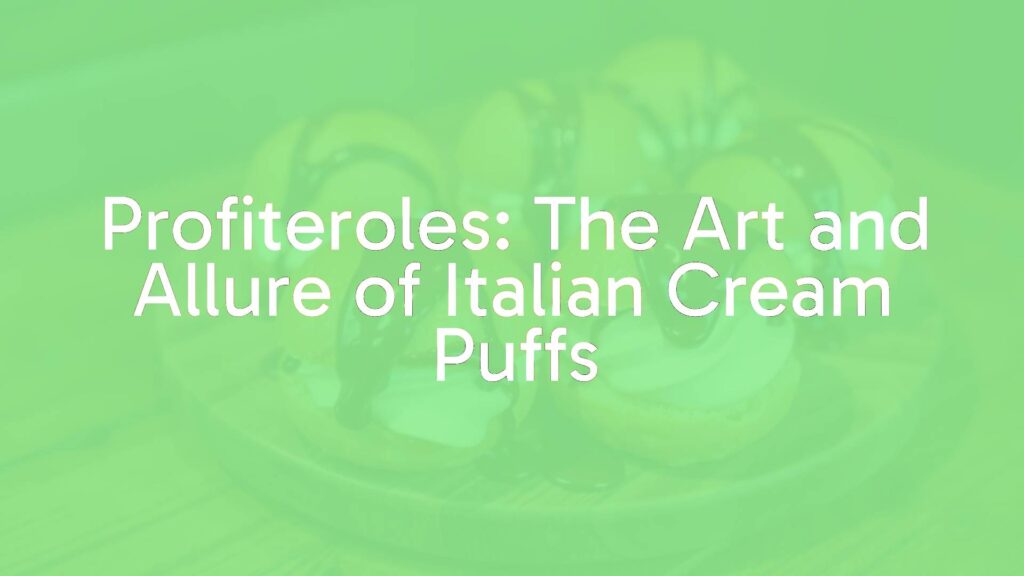Exploring Profiteroles: A Beloved Italian Dessert
Profiteroles, known as “bignè” in Italy, are delicate cream puffs celebrated for their crisp choux pastry shells filled with airy creams and often drizzled with chocolate sauce. While their origins can be traced to French culinary traditions, profiteroles have claimed a cherished place in Italian patisserie, gracing both modest gatherings and lavish feasts across the country. Their combination of light texture, subtle sweetness, and dramatic presentation makes them a truly distinctive dessert in Italian cuisine.
Signature Features of Profiteroles
The hallmark of profiteroles is the choux pastry: a dough that bakes into a golden, hollow shell with a crisp exterior and a tender, airy interior. Once cooled, the shells are traditionally filled with sweetened whipped cream, rich pastry cream, or occasionally gelato. A generous coating of glossy chocolate sauce adds visual allure and indulgent flavor, while the dessert’s overall appearance—often arranged in towering pyramids—makes it a showstopper at any celebration.
Historical Roots and Italian Significance
Profiteroles have their roots in early Renaissance Europe, with culinary influences shared between France and Italy. Catherine de’ Medici is often credited for bringing choux pastry techniques to France from Florence in the 16th century, though the exact lineage is debated. In Italy, profiteroles evolved into a classic finale for festive meals, especially during holidays and family gatherings. Today, they can be found in pastry shops throughout Italy, from elegant Milanese bakeries to rustic Sicilian cafés, showcasing the country’s deep affection for this versatile treat.
Core Ingredients and Variations
The foundational elements of profiteroles include:
- Choux pastry (flour, butter, water, and eggs)
- Filling: whipped cream, Chantilly cream, custard, or ice cream
- Chocolate sauce: typically made from dark or bittersweet chocolate, sometimes enriched with cream
While the classic Italian filling tends to be sweetened cream or custard, inventive bakers may use pistachio, hazelnut, or zabaione creams for local flair. In warmer months, the shells are occasionally filled with gelato, offering a refreshing twist on the traditional version.
Culinary Adaptations Across Italy
Regional interpretations of profiteroles abound. In Naples, some pastry chefs add a dash of liqueur to the pastry cream, while Tuscan varieties may be dusted with powdered sugar before the chocolate is poured. In Sicily, ricotta-based fillings echo the flavors of local cannoli. Across the country, profiteroles are served as either single large puffs or smaller bite-sized options, and some creative versions utilize white chocolate, caramel, or fruit-infused toppings for added dimension.
Serving and Pairing Suggestions
Profiteroles shine as the grand finale to both formal banquets and simple meals. For a dramatic presentation, they are often assembled into a croquembouche-like tower or neatly stacked on a platter, then lavishly dressed in chocolate. They are best enjoyed freshly assembled, when the choux pastry still offers some crispness.
To complement their sweetness, serve profiteroles alongside a glass of Moscato d’Asti or Vin Santo, or opt for a strong Italian espresso. For a festive twist, they pair beautifully with sparkling wines or dessert liqueurs. Fresh berries, toasted nuts, or a dusting of cocoa powder may be added for extra flavor and visual appeal.
A Lasting Icon of Italian Sweetness
With their perfect harmony of crisp pastry, velvety filling, and decadent sauce, profiteroles embody the artistry and indulgence at the heart of Italian pastry-making. Whether created as a simple treat or an extravagant centerpiece, profiteroles continue to delight dessert lovers in Italy and around the world.

